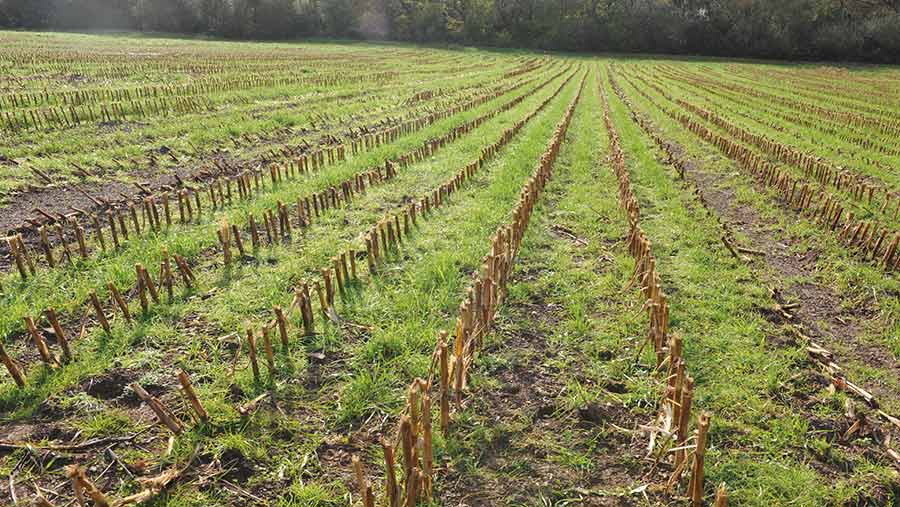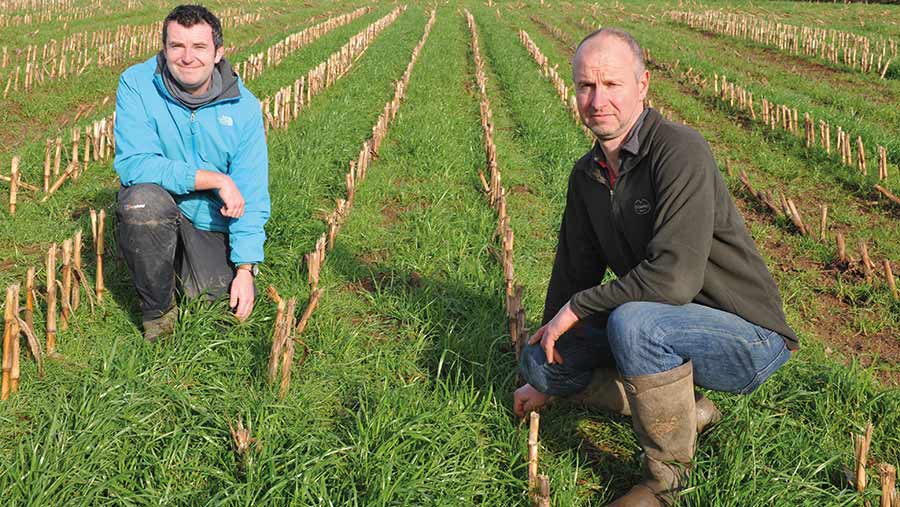How undersowing can help soils and bring grazing income
 Undersowing maize with grass at Arnold's Hill Farm © Debbie James
Undersowing maize with grass at Arnold's Hill Farm © Debbie James Undersowing maize with companion grass mixes as winter grazing for sheep is returning a profit for a Welsh livestock farm, while also protecting soils.
Mathew Van Dijk undersowed 5ha (12 acres) of maize at Arnold’s Hill Farm, near Haverfordwest, as part of a Farming Connect focus farm project to weigh up the economic and environmental benefits of this approach.
The figures from that trial have now been published and show the system to be a profitable one.
See also: How maize undersown with grass provides two-fold benefit
The grass yielded an average of 2.5-3t dry matter (DM)/ha to provide 5,240 sheep grazing days from December 2021 to April 2022.
At an income of £0.90 a head a week, this yielded an income of £674; the total input cost for grass seed and drilling was £435.
Mr Van Dijk says the main aim of undersowing had been to prevent the loss of soil organic matter and nutrient leaching, which occurs when fields used for growing maize are left bare over the winter.
“These figures show that it is economically viable, too,” he says.
Farm facts
- 121ha (299 acres) farmed
- 60 beef suckler cows
- Maize grown on contract
Building resilience
Mr Van Dijk had been so convinced by the research on this system that he had already extended undersowing beyond the trial area to incorporate his entire 28ha (69-acre) crop in 2021.
He is growing more maize this year – 51ha (126 acres) – and will undersow 36ha (89 acres) of that. The remaining area is in its third year under maize, so he will be planting it with winter barley or winter wheat instead.
He believes it is important for farmers to act before regulation on protecting watercourses from phosphates forces the industry in that direction.
“As farmers, we need to understand more about our soils – if the soil isn’t right, the crop isn’t going to grow,” he points out.

Mathew Van Dijk (right) with Gareth Williams from ProCam © Debbie James
Adopting growing practices such as undersowing will make the industry more resilient to challenges from regulators and climate change alike, he adds.
Many of Mr Van Dijk’s fields have a sloping aspect. This makes them vulnerable to erosion and run-off when they are bare because there is no root structure to hold onto the soil.
Sowing a crop or cover after the harvest can be problematic because of autumn soil condition and late sowing – but undersowing provides a potential solution.
It is already widely practised in the Netherlands, where cover crop establishment after maize cultivation on sandy soils is required by law. As a consequence, nearly all maize fields are undersown.
Seed mixes
The grass cover crop at Arnold’s Hill Farm was drilled at the beginning of July 2021 by Pembrokeshire contractor James George, using a Zocon tine drill.
The crop of Augustus maize was harvested at the end of September and yielded about 43t/ha, similar to previous years when the crop was not undersown.
After harvesting, the grass cover was left to bulk up before grazing from December onwards.
To compare performance, four different seed mixes were used for the trial: Italian ryegrass, a straight tetraploid perennial ryegrass, an Italian ryegrass with winter vetch and an Italian ryegrass with berseem clover.
The plots that provided the most cover were the Italian ryegrass and the mix of Italian ryegrass and vetch.
However, Procam agronomist Gareth Williams, the adviser on the Farming Connect project, says incorporating vetch delivered additional benefits, as it is nitrogen-fixing and high in protein.
As he had anticipated, the plot incorporating the berseem clover was negatively affected by the maize herbicide.
Timing
The target period for sowing a cover crop into maize starts one week after the last herbicide is applied, when maize plants are at the six- or seven-leaf stage.
Mr Williams says this prevents them from being smothered by the grass.
“The ley in this trial established well, and there was no negative effect on the maize yield,” he says.
Undersowing also helps to retain 40kg N/ha in the soil, he calculates. This is good for the soil, but is also financially important when fertiliser prices are so high.
In addition, it provides a more stable surface for heavy machinery at harvesting.
But there are some considerations. Because of the presence of the maize crop, the grass seed cannot be rolled, so seed-to-soil contact may be limited.
Future plans
Mr Van Dijk is considering cutting some of the grass as a forage crop.
“It filled out well last year and, as long as the conditions allow and we don’t make a mess when we harvest the maize, we will look at cutting one or two fields for first-cut silage,” he says.
Of the four grass mixes he trialled, he is opting to grow Italian ryegrass this year.
“From a commercial point of view it offers the most bulk, but we will see how the plots we planted last year with vetch and clover behave, to see if those offer benefits to the soil beyond that of the Italian ryegrass,” he says.
Arnold’s Hill Farm grazing programme* |
||
|
Grazing month |
Number of grazing days |
Number of stock grazing |
|
December 2021 |
17 |
160 ewe lambs |
|
February 2022 |
7 |
160 ewe lambs |
|
April 2022 |
20 |
70 store lambs, plus 12 cattle to clean up ley |
|
*For 5ha (12 acres) undersown grass following maize harvest |
||
Establishment costs and income from grazing
Costs
- Grass seed (Italian ryegrass option) 5ha at £50/ha = £250
- Drilling: 5ha at £37/ha = £185
- Total costs = £435
Income
- Total sheep grazing days = 5,240
- Income from tack = £0.90 a head a week
- Total return = £674
Top tips for undersowing
- Seek advice from an agronomist
- Select fields with low weed pressure
- Treat fields with glyphosate before cultivation to create a weed-free seed-bed
- Select the correct grass species for the job
